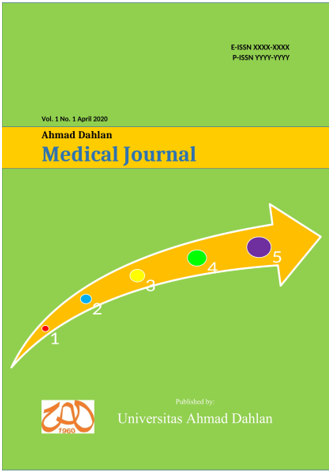Early Detection of Mental Health of Doctoral Students UAD due to the Covid-19 Pandemic through the Questionnaire Method
Abstract
Stress and a decrease in student learning achievement can be triggered by the mal-adaptive coping experienced, especially during the COVID-19 pandemic which requires students to adjust physically and psychologically in the learning process on campus which is now done online and is more independent in learning. So, psychological support for students, especially UAD doctoral students, needs to be done, one of which is mental health screening. The purpose of this study was to determine the mental health condition and social support of students. In the end, this will be the basis for providing psychological support and improving educational and learning activities for UAD Doctoral program students. The research method used was the adjustment and validation of the Self-Report Questionnaire (SRQ) 29, covering aspects of mental health, namely anxiety, depression, stress, use of psychostimulants/substances, symptoms of psychosis (reality rating disorder) and post-traumatic stress disorder (PTSD); Customize and validate social support questionnaires; Submission of ethical review; and Conducting an online survey of mental health, anxiety, depression and social support for Doctoral students. The results obtained from SRQ29 showed that as many as 30% of students experienced PTSD and 10% experienced depression. However, the results of the high religiosity test and quality of life were not compromised. The conclusion of this study is that the existence of religiosity and spirituality can provide positive coping to reduce mental disorders and improve the quality of life for students during the COVID-19 pandemic.
References
Cheah, W. L. et al. (2021) ‘Quality of life among undergraduate university students during COVID-19 movement control order in Sarawak’, Health Science Reports, 4(3), pp. 4–10. doi: 10.1002/hsr2.362.
Desvita, W. R. et al. (2022) ‘Pandemi Covid-19 Screening of Mental Health , Religiusity , and Quality of Life of Pharmaceutical and Medical Students in the Covid-19 Pandemic’, Medical Sains : Jurnal Ilmiah Kefarmasian, 7(2), pp. 293–300.
Endarti, A. T. et al. (2020) ‘Kemampuan Koping Dan Penurunan Kualitas Hidup Individu Di Era Pandemik COVID-19 Di Jakarta Timur Dan Wilayah Sekitarnya’, Prosiding Forum Ilmiah Tahunan IAKMI, pp. 25–26.
Fawaz, M. and Samaha, A. (2021) ‘E-learning: Depression, anxiety, and stress symptomatology among Lebanese university students during COVID-19 quarantine’, Nursing Forum, 56(1), pp. 52–57. doi: 10.1111/nuf.12521.
Khoiri Oktavia, W. and Muhopilah, P. (2021) ‘Model Konseptual Resiliensi di Masa Pandemi Covid-19: Pengaruh Religiusitas, Dukungan Sosial dan Spiritualitas’, Psikologika: Jurnal Pemikiran dan Penelitian Psikologi, 26(1), pp. 1–18. doi: 10.20885/psikologika.vol26.iss1.art1.
Norrholm, S. D. et al. (2011) ‘Fear extinction in traumatized civilians with posttraumatic stress disorder: Relation to symptom severity’, Biological Psychiatry. Elsevier Inc., 69(6), pp. 556–563. doi: 10.1016/j.biopsych.2010.09.013.
Rau, V., DeCola, J. P. and Fanselow, M. S. (2005) ‘Stress-induced enhancement of fear learning: An animal model of posttraumatic stress disorder’, Neuroscience and Biobehavioral Reviews, 29(8), pp. 1207–1223. doi: 10.1016/j.neubiorev.2005.04.010.
Salari, N. et al. (2020) ‘Prevalence of stress, anxiety, depression among the general population during the COVID-19 pandemic: a systematic review and meta-analysis’, Globalization and Health. Globalization and Health, 16(1), pp. 1–11.
Sifat, R. I. (2021) ‘COVID-19 pandemic: Mental stress, depression, anxiety among the university students in Bangladesh’, International Journal of Social Psychiatry, 67(5), pp. 609–610. doi: 10.1177/0020764020965995.
Sulistyorini, A. and Pujianto, T. (2020) ‘The Description of Mental Health and Emotional Mental Disorders of Students And Families During Covid-19 Pandemic’, Journal Of Nursing Practice, 4(1), pp. 97–106. doi: 10.30994/jnp.v4i1.119.
Wang, X. et al. (2020) ‘Investigating mental health of US college students during the COVID-19 pandemic: Cross-sectional survey study’, Journal of Medical Internet Research, 22(9). doi: 10.2196/22817.
Downloads
Published
How to Cite
Issue
Section
License
Copyright (c) 2022 Muhammad Agita Hutomo

This work is licensed under a Creative Commons Attribution-ShareAlike 4.0 International License.
License and Copyright Agreement
In submitting the manuscript to the journal, the authors certify that:
- They are authorized by their co-authors to enter into these arrangements.
- The work described has not been formally published before, except in the form of an abstract or as part of a published lecture, review, thesis, or overlay journal. Please also carefully read Ahmad Dahlan Medical Journal posting Your Article Policy.
- That it is not under consideration for publication elsewhere.
- That its publication has been approved by all the author(s) and by the responsible authorities - tacitly or explicitly - of the institutes where the work has been carried out.
- They secure the right to reproduce any material that has already been published or copyrighted elsewhere.
- They agree to the following license and copyright agreement.
Copyright
Authors who publish with Ahmad Dahlan Medical Journal agree to the following terms:
- Authors retain copyright and grant the journal right of first publication with the work simultaneously licensed under a Creative Commons Attribution License (CC BY-SA 4.0) that allows others to share the work with an acknowledgment of the work's authorship and initial publication in this journal.
- Authors are able to enter into separate, additional contractual arrangements for the non-exclusive distribution of the journal's published version of the work (e.g., post it to an institutional repository or publish it in a book), with an acknowledgment of its initial publication in this journal.
- Authors are permitted and encouraged to post their work online (e.g., in institutional repositories or on their website) prior to and during the submission process, as it can lead to productive exchanges, as well as earlier and greater citation of published work.


